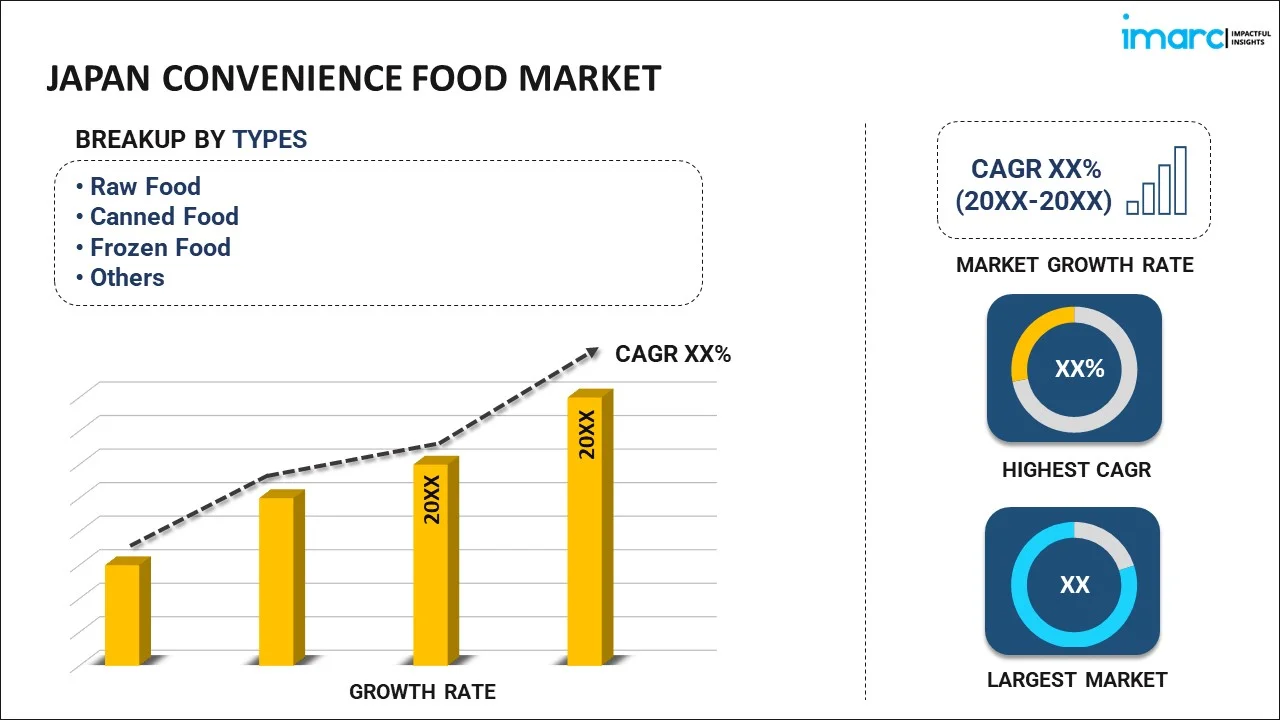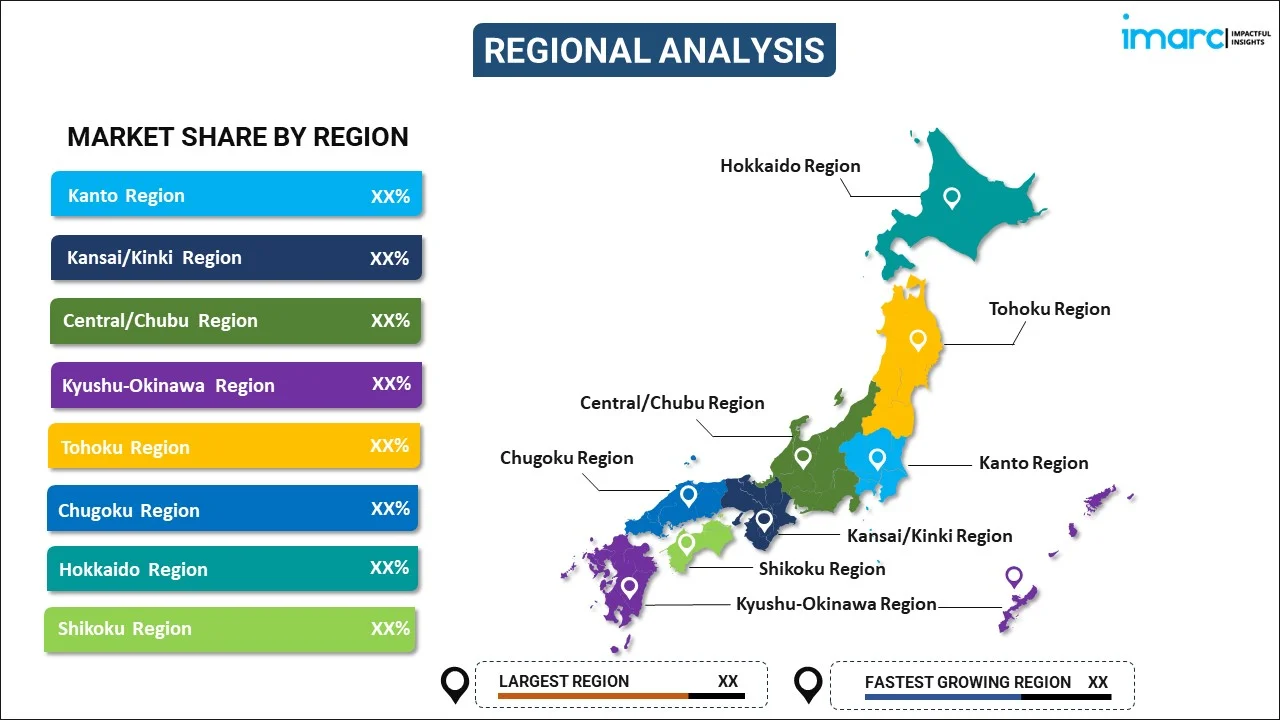
Japan Convenience Food Market Report by Type (Raw Food, Canned Food, Frozen Food, Ready-To-Eat, Ready-To-Cook, and Others), Product (Meat/Poultry Products, Cereal-based Products, Vegetable-based Products, and Others), Distribution Channel (Supermarkets and Hypermarkets, Convenience Stores, Specialty Stores, and Others), and Region 2025-2033
Market Overview:
The Japan convenience food market size reached USD 30,227.0 Million in 2024. Looking forward, IMARC Group expects the market to reach USD 34,086.1 Million by 2033, exhibiting a growth rate (CAGR) of 1.3% during 2025-2033. The increasing demand for convenient food options among busy individuals, the growing geriatric population adopting convenience food options, and the growing popularity of convenience stores or konbini that offer numerous ready-to-eat (RTE) meals, snacks, and beverages represent some of the key factors driving the market.
|
Report Attribute
|
Key Statistics
|
|---|---|
|
Base Year
|
2024 |
|
Forecast Years
|
2025-2033
|
|
Historical Years
|
2019-2024
|
| Market Size in 2024 | USD 30,227.0 Million |
| Market Forecast in 2033 | USD 34,086.1 Million |
| Market Growth Rate (2025-2033) | 1.3% |
Convenience food refers to pre-packaged, ready-to-eat (RTE), or easy-to-prepare food products developed to save consumers time and effort in meal preparation. These foods are typically found in grocery stores and can range from frozen dinners and canned soups to instant noodles and microwaveable snacks. It is gaining popularity due to their convenience, making them a convenient choice for individuals with busy lifestyles or limited culinary skills. Additionally, the appeal of convenience food lies in its quick and hassle-free preparation, often requiring minimal cooking or assembly. It provides a solution for individuals looking for a fast meal option without compromising too much on taste, nutrition, or convenience.. Nowadays, companies are making informed decisions about product development, marketing strategies, and positioning in this competitive industry by analyzing data and insights related to convenience food consumption.
Japan Convenience Food Market Trends:
The Japanese convenience food market is primarily driven by the increasing demand for convenient food options. In addition, as more individuals juggle work, commuting, and personal commitments, the need for quick and easy meal solutions is influencing the market growth. It also provides a time-saving alternative to traditional cooking. Moreover, continuous innovation in convenience food products, such as healthier options, international cuisines, and gourmet selections, represents another major growth-inducing factor. Japanese consumers are seeking several high-quality choices within the convenience food category. Along with this, the growing number of single-person households, including young professionals and geriatric individuals living alone are escalating the demand for portion-controlled and single-serving convenience food products offering masses the convenient options that reduce food wastage, propelling the market growth. Besides this, the growing awareness of health and nutrition among Japanese consumers led consumers to seek convenience foods that align with their health and dietary goals, accelerating the market growth. Also, companies that offer healthier convenience food options can gain a competitive edge, influencing market growth. Apart from this, Increasing awareness of environmental sustainability has led some consumers to look for eco-friendly packaging and sustainable practices among convenience food brands, which is contributing to the market growth. Additionally, the growing geriatric population often prefers ready-to-eat (RTE) meals that require minimal preparation, as it can be challenging for them to cook elaborate meals, which is creating a substantial market for convenience food tailored to older consumers. Japan has a well-established culture of convenience stores or konbini that offer numerous ready-to-eat (RTE) meals, snacks, and beverages, which serve as convenient outlets for purchasing such products, further escalating the demand for convenience foods.
Japan Convenience Food Market Segmentation:
IMARC Group provides an analysis of the key trends in each segment of the market, along with forecasts at the country level for 2025-2033. Our report has categorized the market based on type, product, and distribution channel.
Type Insights:

- Raw Food
- Canned Food
- Frozen Food
- Ready-To-Eat
- Ready-To-Cook
- Others
The report has provided a detailed breakup and analysis of the market based on the type. This includes raw food, canned food, frozen food, ready-to-eat, ready-to-cook, and others.
Product Insights:
- Meat/Poultry Products
- Cereal-based Products
- Vegetable-based Products
- Others
A detailed breakup and analysis of the market based on the product have also been provided in the report. This includes meat/poultry products, cereal-based products, vegetable-based products, and others.
Distribution Channel Insights:
- Supermarkets and Hypermarkets
- Convenience Stores
- Specialty Stores
- Others
The report has provided a detailed breakup and analysis of the market based on the distribution channel. This includes supermarkets and hypermarkets, convenience stores, specialty stores, and others.
Regional Insights:

- Kanto Region
- Kansai/Kinki Region
- Central/ Chubu Region
- Kyushu-Okinawa Region
- Tohoku Region
- Chugoku Region
- Hokkaido Region
- Shikoku Region
The report has also provided a comprehensive analysis of all the major regional markets, which include Kanto Region, Kansai/Kinki Region, Central/ Chubu Region, Kyushu-Okinawa Region, Tohoku Region, Chugoku Region, Hokkaido Region, and Shikoku Region.
Competitive Landscape:
The market research report has also provided a comprehensive analysis of the competitive landscape. Competitive analysis such as market structure, key player positioning, top winning strategies, competitive dashboard, and company evaluation quadrant has been covered in the report. Also, detailed profiles of all major companies have been provided.
Japan Convenience Food Market Report Coverage:
| Report Features | Details |
|---|---|
| Base Year of the Analysis | 2024 |
| Historical Period | 2019-2024 |
| Forecast Period | 2025-2033 |
| Units | Million USD |
| Scope of the Report | Exploration of Historical Trends and Market Outlook, Industry Catalysts and Challenges, Segment-Wise Historical and Future Market Assessment:
|
| Types Covered | Raw Food, Canned Food, Frozen Food, Ready-To-Eat, Ready-To-Cook, Others |
| Products Covered | Meat/Poultry Products, Cereal-based Products, Vegetable-based Products, Others |
| Distribution Channels Covered | Supermarkets and Hypermarkets, Convenience Stores, Specialty Stores, Others |
| Regions Covered | Kanto Region, Kansai/Kinki Region, Central/ Chubu Region, Kyushu-Okinawa Region, Tohoku Region, Chugoku Region, Hokkaido Region, Shikoku Region |
| Customization Scope | 10% Free Customization |
| Post-Sale Analyst Support | 10-12 Weeks |
| Delivery Format | PDF and Excel through Email (We can also provide the editable version of the report in PPT/Word format on special request) |
Key Questions Answered in This Report:
- How has the Japan convenience food market performed so far and how will it perform in the coming years?
- What has been the impact of COVID-19 on the Japan convenience food market?
- What is the breakup of the Japan convenience food market on the basis of type?
- What is the breakup of the Japan convenience food market on the basis of product?
- What is the breakup of the Japan convenience food market on the basis of distribution channel?
- What are the various stages in the value chain of the Japan convenience food market?
- What are the key driving factors and challenges in the Japan convenience food?
- What is the structure of the Japan convenience food market and who are the key players?
- What is the degree of competition in the Japan convenience food market?
Key Benefits for Stakeholders:
- IMARC’s industry report offers a comprehensive quantitative analysis of various market segments, historical and current market trends, market forecasts, and dynamics of the Japan convenience food market from 2019-2033.
- The research report provides the latest information on the market drivers, challenges, and opportunities in the Japan convenience food market.
- Porter's five forces analysis assist stakeholders in assessing the impact of new entrants, competitive rivalry, supplier power, buyer power, and the threat of substitution. It helps stakeholders to analyze the level of competition within the Japan convenience food industry and its attractiveness.
- Competitive landscape allows stakeholders to understand their competitive environment and provides an insight into the current positions of key players in the market.
Need more help?
- Speak to our experienced analysts for insights on the current market scenarios.
- Include additional segments and countries to customize the report as per your requirement.
- Gain an unparalleled competitive advantage in your domain by understanding how to utilize the report and positively impacting your operations and revenue.
- For further assistance, please connect with our analysts.
 Request Customization
Request Customization
 Speak to an Analyst
Speak to an Analyst
 Request Brochure
Request Brochure
 Inquire Before Buying
Inquire Before Buying




.webp)




.webp)












